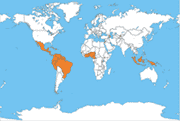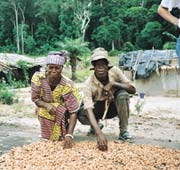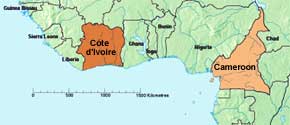|
|
|
|
|
|
|
|
|
|
|
|
|
|
Cocoa - useful web sites:
|

Sustainable agriculture - cocoa farming
The cocoa (cacao) tree is native to the tropical rainforests of South and Central America. The beans were first used by the Mayans, then the Aztecs, to make a bitter drink called chocolatl. They were also used as currency - 100 beans could buy a rabbit! The Spanish explorer, Cortes, first brought cocoa beans to Europe in 1528, but it wasn't until sugar was added to the drink that it became popular, drunk hot rather than cold and made from a tablet which could be crumbled. It remained a drink of the rich until the invention of the hydraulic cocoa press brought major changes to processing. Cocoa butter could then be separated out from the beans, making a more appetising, less fatty drink. J.S. Fry & Sons (Bristol) are credited with producing the first "eating chocolate". The first milk chocolate was produced in Switzerland in 1875 by adding powdered milk to the cocoa. By the 1930's, companies like Cadbury, Mars and Rowntree were mass producing a range of chocolate confectionery in the UK. To meet this demand, cocoa trees were planted in South America and introduced into new regions of Africa and Asia. Cocoa is now a major source of income for 11 million farmers, mainly in South East Asia, South and Central America and West Africa.
Towards a sustainable future: International Workshop, Panama In 1998 the worldwide cocoa community (the chocolate industry, researchers, conservationists, NGOs and economists) met at the Smithsonian Tropical Research Institute in Panama to try to determine what sustainable cocoa production should be like. The main findings were that:
It was recognised that cocoa grown in the right way had benefits for the tropical environment compared to other crop systems, and that it was a good cash crop for many smallholders. Some of the most interesting results on sustainable cocoa production presented at Panama came from the International Institute of Tropical Agriculture Humid Forest Station based at Yaoundé in Cameroon. Cocoa farming in West Africa
| ||||||||||||||||||||||||||||||||||||||||||||||||||||



